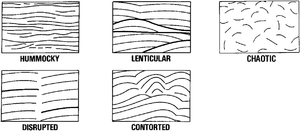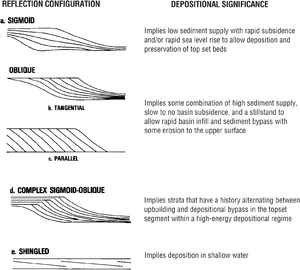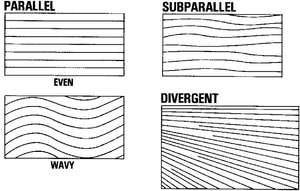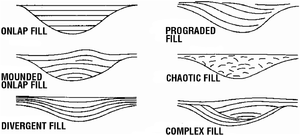Reflection configuration patterns
| Exploring for Oil and Gas Traps | |

| |
| Series | Treatise in Petroleum Geology |
|---|---|
| Part | Predicting the occurrence of oil and gas traps |
| Chapter | Exploring for stratigraphic traps |
| Author | John C. Dolson, Mike S. Bahorich, Rick C. Tobin, Edward A. Beaumont, Louis J. Terlikoski, Michael L. Hendricks |
| Link | Web page |
| Store | AAPG Store |
Groups of configuration patterns
Reflection configuration patterns can be divided into three groups:
- Parallel—including subparallel and divergent
- Discontinuous
- Prograding—caused by lateral accretion of strata
Parallel reflector patterns
Parallel reflections include subparallel, wavy, and divergent. Parallel, subparallel, and wavy reflectors suggest uniform depositional rates on a uniformly subsiding surface, such as a shelf or basin plain. Divergent reflectors suggest lateral variations in depositional rates or progressive tilting of a depositional surface. Figure 1 shows reflection configurations for this group.
Discontinuous reflector patterns
Five types of discontinuous reflector patterns that help interdepositional systems are shown in the figure below. Hummocky strata may be discontinuous point bars and crevasse splays. Chaotic reflectors suggest coarse-grained fluvial or turbidite channel fills. Contorted features may be shale-prone debris flows. Precise identification of depositional environments requires integration with other data.


Prograding reflector patterns
One of the most common depositional features observed in seismic sections are clinoforms manifested in a configuration pattern called offlap. Clinoforms are progradational strata that form through the progressive development of gently sloping surfaces. Paleowater depths can be interpreted from the height of prograding clinoforms. Figure 2 shows prograding reflectors and their possible depositional significance.
Channel fill patterns
Channels are expressed in seismic sections as negative relief features truncating the underlying strata. Fill patterns are shown in Figure 3.
See also
- Facies analysis
- Basics of seismic facies analysis
- Seismic facies mapping
- Analyzing individual reflectors
- Techniques for enhancing seismic facies analysis
- Analyzing lithofacies
- Petrophysical analysis of lithofacies
References
- ↑ 1.0 1.1 Mitchum, R., M., Vail, P., R., Sangree, J., B., 1977, Seismic stratigraphy and global changes in sea level, part 6: stratigraphic interpretations of seismic reflection patterns in depositional sequences, in Payton, C., E., ed., Seismic Stratigraphy and Applications to Hydrocarbon Exploration: AAPG Memoir 26, p. 117–133.

